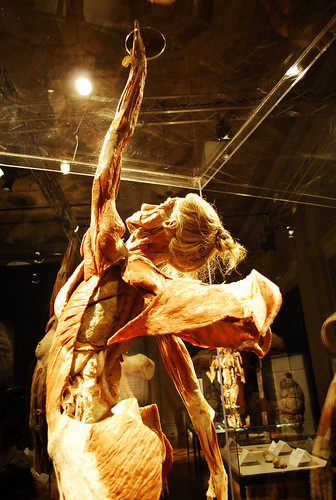The Franklin Institute’s second edition of Body Worlds offers more skin.

When the first Body Worlds exhibit came to the Franklin Institute, the exhibit garnered much popularity. People visiting the exhibit had to purchase tickets in advance in order to ensure they would be able to witness the exhibit. And with its return to the museum, the popularity has not waned.
The international traveling exhibit has returned to Philadelphia with its second installment, “Body Worlds 2 & the Brain,” and brought back the same crowds as well.
“I think the exhibit is so popular because it actually allows people to see full actual human body specimens,” said Dr. Frederic Bertley, vice president of the Center for Innovation in Science Learning. “Also, we as humans have a natural fascination with ourselves.”
The exhibit features complete authentic human specimens in poses ranging from a diver jumping headfirst in an imaginary pool, to a woman in a yoga position. Some even have muscles pulled back to show all the inner workings of the human body beneath the layers.
Organs, bones and organ systems in display cases give a in-depth look at the human body. Healthy body parts are laid out in comparison to organs riddled with health maladies. One notable comparison is a set of healthy lungs next to an ashened smoker’s lung. At the end of these two pairs of lungs was the glittering, black lung of a coal miner who breathed in large amounts of soot during his time on the job.
The star of the show, however, was the brain. The exhibit focused on the complex organ in our head featuring specimens of the brain in its healthiest form to one that has been severely damaged by Alzheimer’s disease. The new exhibit focuses on the brain by providing new facts and discoveries in the world of neuroscience. Posters around the exhibit give detailed facts on how things like our brain develop, as well as provide information on how addictions occur in individuals.
Not all the specimens in the exhibit are human. In a room in the back of the exhibit is the massive body of a camel with an opening on the side revealing what the camel had eaten that day.
All the bodies in the exhibit have been preserved in their full form through the process of plastination, which was discovered by Dr. Gunther von Hagen in 1977. The process involves removing water and fats from the body and replacing them with polymers, in order to halt decomposition.
The human specimens within the exhibit have all been donated through a body donation program connected to the exhibit, which entails the same principle as becoming an organ donor, only a little more complicated. All donors must sign a consent form and may remove themselves from the list at anytime during their lives.
Individuals may sign up for the program either at the end of the exhibit or by visiting bodyworlds.com. Signing up for the program has become almost as popular as the exhibit itself.
Bertley said as many as “10,000 bodies have been donated to date.”
Stephen Kimmerly can be reached at stephen.kimmerly@temple.edu.



Be the first to comment